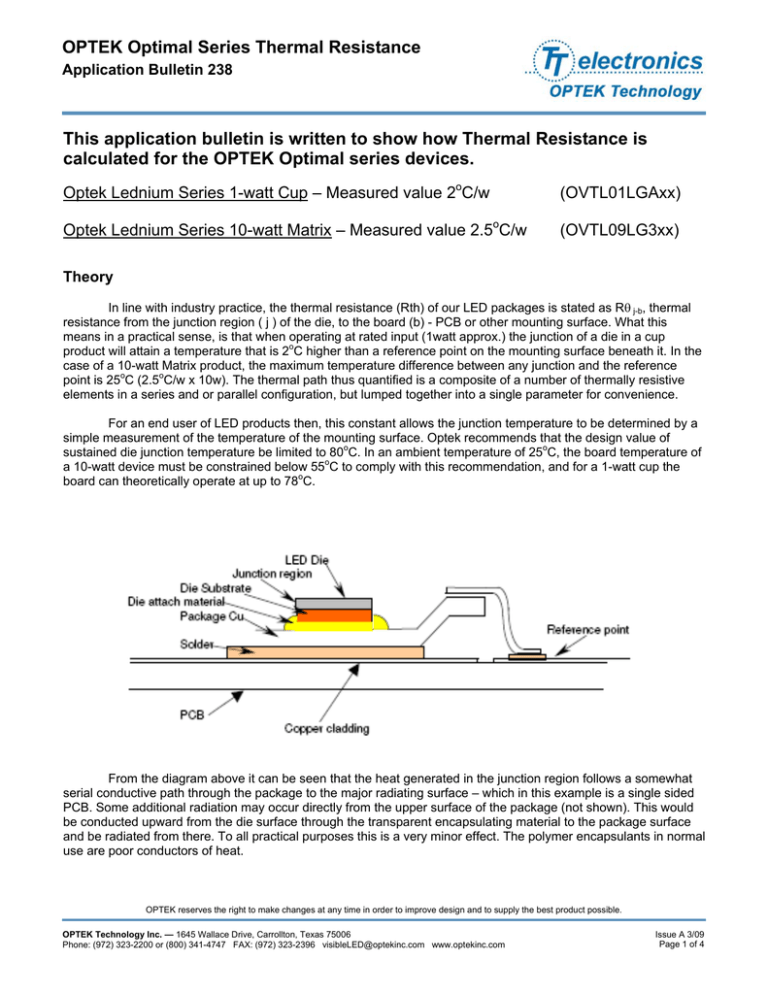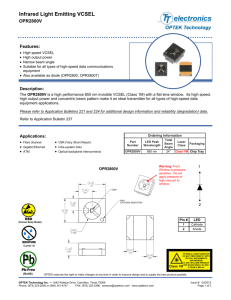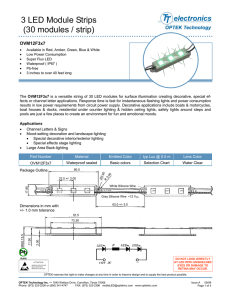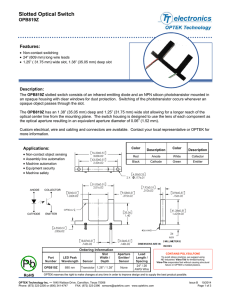OPTEK Optimal Series Thermal Resistance This application bulletin
advertisement

OPTEK Optimal Series Thermal Resistance
Application Bulletin 238
This application bulletin is written to show how Thermal Resistance is
calculated for the OPTEK Optimal series devices.
Optek Lednium Series 1-watt Cup – Measured value 2oC/w
(OVTL01LGAxx)
Optek Lednium Series 10-watt Matrix – Measured value 2.5oC/w
(OVTL09LG3xx)
Theory
In line with industry practice, the thermal resistance (Rth) of our LED packages is stated as Rθ j-b, thermal
resistance from the junction region ( j ) of the die, to the board (b) - PCB or other mounting surface. What this
means in a practical sense, is that when operating at rated input (1watt approx.) the junction of a die in a cup
product will attain a temperature that is 2oC higher than a reference point on the mounting surface beneath it. In the
case of a 10-watt Matrix product, the maximum temperature difference between any junction and the reference
point is 25oC (2.5oC/w x 10w). The thermal path thus quantified is a composite of a number of thermally resistive
elements in a series and or parallel configuration, but lumped together into a single parameter for convenience.
For an end user of LED products then, this constant allows the junction temperature to be determined by a
simple measurement of the temperature of the mounting surface. Optek recommends that the design value of
sustained die junction temperature be limited to 80oC. In an ambient temperature of 25oC, the board temperature of
a 10-watt device must be constrained below 55oC to comply with this recommendation, and for a 1-watt cup the
board can theoretically operate at up to 78oC.
From the diagram above it can be seen that the heat generated in the junction region follows a somewhat
serial conductive path through the package to the major radiating surface – which in this example is a single sided
PCB. Some additional radiation may occur directly from the upper surface of the package (not shown). This would
be conducted upward from the die surface through the transparent encapsulating material to the package surface
and be radiated from there. To all practical purposes this is a very minor effect. The polymer encapsulants in normal
use are poor conductors of heat.
OPTEK reserves the right to make changes at any time in order to improve design and to supply the best product possible.
OPTEK Technology Inc. — 1645 Wallace Drive, Carrollton, Texas 75006
Phone: (972) 323-2200 or (800) 341-4747 FAX: (972) 323-2396 visibleLED@optekinc.com www.optekinc.com
Issue A 3/09
Page 1 of 4
OPTEK Optimal Series Thermal Resistance
Application Bulletin 238
Typical elements in the conducting path and corresponding nominal thermal conductivities are:
Elements
w/mK
Epilayers
GaN/InGaN
150
Substrate
Sapphire
50
Die attach material
Conductive epoxy
10
Package
Silver plated copper
Solder
Solder (Sn/Ag/Cu)
Copper cladding
Copper
350
35
300
Note : Thermal conductivity is a physical constant. For the materials above, the respective contribution each makes
to the overall thermal resistance (Rθ j-b) is a function of the thickness of each material layer, and the surface area.
Thermal Conductivity (TC) is defined to be the heat conducted in time (t), through thickness (T) in a direction normal
to a surface area (A), due to a temperature difference (δT).
Therefore
TC= q/t x {T/[A x δT]}
and
δT = [Q x T]/[A x TC]
where δT = Temp. difference (K)
Q = Power (w)
A = Surface area (m2)
T = layer thickness (m)
TC = Thermal Conductivity (w/mK)
Theoretical Calculation (for 1 watt dissipated in a cup product via a single 40mil die)
GaN
Thickness approx 10 x 10-6
Area 10-6
= 1 x 10x10-6/ 10-6 x 150
= 0.07 K
Substrate
T = 60 x 10-6
= 1 x 60x10-6/ 10-6 x 50
= 1.2 K
Die attach
T = 20 x 10-6
A = 2 x 10-6
= 1 x 20x10-6 / 2x10-6 x 10
=1
Package
T = 0.4x10-3
A = 6x10-6
= 1 x 0.4x10-3/ 6x10-6 x 350
= 0.19
Solder
T = 60x10-6
A = 6x10-6
= 1 x 60x10-6/6x10-6 x 25
= 0.4
Total Calculated δT = 2.86K
OPTEK reserves the right to make changes at any time in order to improve design and to supply the best product possible.
Issue A 3/09
Page 2 of 4
OPTEK Technology Inc. — 1645 Wallace Drive, Carrollton, Texas 75006
Phone: (972) 323-2200 or (800) 341-4747 FAX: (972) 323-2396 visibleLED@optekinc.com www.optekinc.com
OPTEK Optimal Series Thermal Resistance
Application Bulletin 238
Power input is 1 watt; however, some power is converted into light energy. Assuming this is of the order of
200mw, the adjusted value of δT is 2.29K. The calculation now assumes that all of the dissipation, 800mw of heat,
is conducted along the thermal path, thereby ignoring any conduction and subsequent radiation that is not directionally normal to the surfaces considered, ie: conduction through the encapsulant material vertically away from the
board, and conduction horizontally away from the heat source. The calculation also assumes that there is no contribution to thermal resistance at the boundaries between material layers. In practice it is improbable that perfect
transfer will occur at these transition regions, even though the bonding between layers in this example are of high
quality. In general, the calculation indicates that the measurements below are of the order of magnitude that can be
expected.
The alternate matrix product range is of a much more complicated thermal design, which does not lend itself to a simple theoretical calculation similar to that shown above. There are multiple incident heat sources, parallel
heat conduction paths, and significantly larger surface area for stray radiation, eg. Cup above has a surface area
available for stray radiation of approximately, 25mm2 per watt of input power. A 10-watt matrix product has approximately 92.5mm2 of exposed surface per input watt.
Measurements
The key to an accurate measurement of thermal resistance is to obtain a reliable value for the junction temperature (Tj). Since the die itself is, and must be, encapsulated during testing, and the junction is contained within
the structure of the die, direct measurement of the junction temperature by normal means is not possible.
Two methods of non-contact thermography are available, both of which rely on emitted infrared detection.
Infrared imagery by calibrated radiograph is a possibility; however, in the instance of a cup product only a
small value of δT is expected which makes accurate estimation of the actual temperature gradient difficult using colorimetry.
The alternative measurement type is digital infrared thermography. This means there is an inherent uncertainty in the calculation algorithm, which sometimes gives results considered unacceptably inaccurate. In this instance absolute accuracy is of secondary importance because the value to be determined is a temperature difference (δT) which requires only relative values – any error in a first reading will also be present in subsequent readings that are about the same value. The difference between readings is accurate.
The other significant drawback to infrared thermometers is a limitation to minimizing the spot size over
which the measurement is made. This poses a difficulty for small assemblies like an LED cup, and in particular the
added complication that the calculated temperature is an average value for the area being interrogated further complicates the issue. Another concern is sometimes raised about the ability of this type of instrument to detect a
heated surface beyond the closest transparent radiating surface. This is a significant issue for far field measurements; however, it is simple to demonstrate that this does not hold true for the near field, and particularly when the
incident beam has a known focal length.
OPTEK reserves the right to make changes at any time in order to improve design and to supply the best product possible.
OPTEK Technology Inc. — 1645 Wallace Drive, Carrollton, Texas 75006
Phone: (972) 323-2200 or (800) 341-4747 FAX: (972) 323-2396 visibleLED@optekinc.com www.optekinc.com
Issue A 3/09
Page 3 of 4
OPTEK Optimal Series Thermal Resistance
Application Bulletin 238
Measurement
Instrument: IR Thermometer
Auto ranging: -100 to 1200oC
Spot size 3mm D.
Focus 25.4mm
Cup Product
Input 350mA at 3.3V(1watt)
Averaged Test Results
Tj
Tb
32
30.2
δT
1.8
Rth
1.8oC/W
Matrix Product
Input 1050mA at 10.2V(10.7watts)
Averaged Test Results
Tj
Tb
δT
89
62
27
Rth
2.52°C/W
OPTEK reserves the right to make changes at any time in order to improve design and to supply the best product possible.
Issue A 3/09
Page 4 of 4
OPTEK Technology Inc. — 1645 Wallace Drive, Carrollton, Texas 75006
Phone: (972) 323-2200 or (800) 341-4747 FAX: (972) 323-2396 visibleLED@optekinc.com www.optekinc.com



